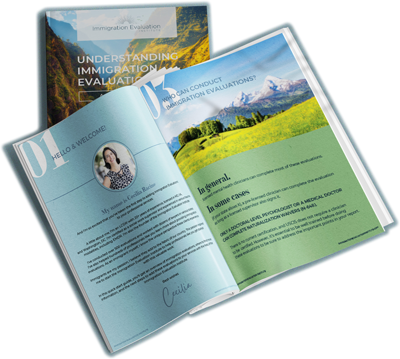What do you want to learn more about?
7 Tips For Crafting High-Quality Immigration Evaluations

As immigration evaluation professionals, our role can significantly shape the lives of immigrants seeking legal status.
Immigration officials and judges rely on our expertise to make crucial decisions that can impact individuals and their families profoundly. In light of this, I know everyone offering evaluations is keen to ensure they do their best.
And I also know that sometimes we question whether we have done the best!
In this blog, I want to address a fundamental question I’m often asked: How do I craft a high-quality evaluation?
I’ll go through some of my top writing tips, including things I highly recommend you must do – and something I absolutely recommend you avoid doing! By adhering to these guidelines, you can ensure the delivery of concise, clear, and professionally presented evaluations.
Crafting a High-Quality Report: 4 Things You Must-Do
Developing your skills in crafting high-quality immigration evaluations is a skill that needs to be developed over time.
By focusing on the foundations of what makes a good evaluation, you can build on this and hone your skills over time. Below are the top three foundational considerations I recommend you focus on to help you on this journey.
- Establish Your Expertise
To instill confidence in your immigration evaluations, a concise and compelling description of your professional background and expertise is vital. Include details about your education, specialized training, and experience in the field of immigration evaluations.
Doing so creates an aura of authority, reinforcing that your evaluation comes from a reputable expert in the field. This establishes the foundation for a well-received assessment.
- Provide Clear Reasoning for Diagnoses and Conclusions
Remember that immigration officials and judges are not mind readers; they need explicit connections between the evidence presented and your final conclusions. When crafting your evaluation, avoid vague statements or unsupported assumptions.
Clearly articulate the rationale behind your diagnoses, ensuring your thought process is evident throughout the document. This will strengthen the credibility of your evaluation and enable decision-makers to understand better and appreciate your professional judgment.
- Double Down on Spell and Grammar Check
Attention to detail is paramount when it comes to preparing professional immigration evaluations. One of the most common pitfalls in evaluation writing is overlooking spelling and grammar errors. Such mistakes can mar the professionalism of your work and, more importantly, may lead to misunderstandings or misinterpretations.
Before submitting your evaluation, conduct thorough spell and grammar checks, and if possible, seek a second pair of eyes for review. A polished, error-free document reflects your commitment to delivering high-quality work.
4. Be Honest
And finally, remember to be honest.
It’s essential that after spending time with a client, we deliver a report that accurately and honestly reflects what we’ve learned about the client.
Sometimes this might not always be ‘good,’ but we must remain professional and deliver in our role ethically, accurately, and non-judgementally.
Crafting a High-Quality Report: 3 Things to Avoid
In my role, I often receive emails and messages from those new to delivering immigration evaluations asking if I could review a report to help them understand where they can improve.
These evaluations are usually excellent, but a few common errors or areas typically come up. Below are the top three things to keep an eye on and avoid when developing your evaluations.
- Avoid Copy-Pasting from Old Evaluations
Using text from previous evaluations might seem convenient but can lead to disastrous consequences. When reusing content, the risk of inadvertently including irrelevant information or mentioning incorrect names or details is significantly higher.
Instead, treat each evaluation as unique and start with a fresh template. Tailor your content to match the specific circumstances of the individual being evaluated. This personalized approach demonstrates diligence and professionalism in your work.
- Steer Clear of Filler Content
Filling your evaluation with redundant or excessive information is time-consuming and can distract from the essential points. There is no need to copy entire diagnostic criteria from the DSM (Diagnostic and Statistical Manual of Mental Disorders) when a concise summary will suffice.
Trim any superfluous content and focus on presenting the most relevant and impactful information. Your evaluation should be a well-crafted, cohesive narrative that answers the referral question efficiently.
- Avoid Irrelevant Information
While providing relevant details is crucial, inundating your evaluation with irrelevant information can be counterproductive. Always refer to the referral question and consider whether each piece of information contributes to answering it effectively.
Avoid going on tangents or including excessive background details unless they directly impact the case. Staying on point saves time and showcases your ability to discern what truly matters in each evaluation.
Practice Makes Perfect
Creating exceptional immigration evaluations requires a combination of expertise, clarity, and attention to detail. It can take time to develop these skills!
My best advice is not to let fears around this stop you from getting started; no one is perfect when they first begin something new, and it’s, for this reason, The Immigration Evaluation Institute Exists. This community is about helping you on this journey to honing this vital skill – and I’m here to support you every step.
Embrace these guidelines, and you’ll be well on your way to becoming a respected authority in your field.If you want further help with developing your skills in this area, my courses include a selection of templates, guidance, and resources to help you write the most effective immigration evaluations. Head to the courses section to find out more.

I’m Cecilia Racine, and I teach therapists how to help immigrants through my online courses. As a bilingual immigrant myself, I know the unique perspective that these clients are experiencing. I’ve conducted over 500 evaluations and work with dozens of lawyers in various states. Immigrants are my passion, I believe they add to the fabric of our country.
related articles
Helping Immigrants Find Safety and Healing Through U and T Visas
As mental health clinicians, we possess a unique set of skills that can be a…
Expand Your Expertise: Recommended Trainings for Immigration Clinicians
The Immigration Evaluation Institute Comprehensive course is a great first step into the world of…
Ethical Considerations in Immigration Evaluations
The role of mental health professionals in immigration evaluations is fraught with unique ethical complexities.…
Join the Free
Immigration evaluation
therapists facebook group
Are you a therapist that conducts immigration evaluations?



